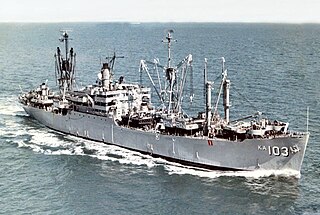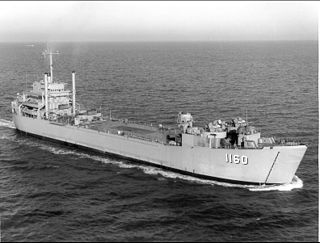
USS Raleigh (LPD-1), the lead ship of her class of amphibious transport docks, was the fourth ship of the United States Navy named for the capital of North Carolina, which in turn honors the English explorer Sir Walter Raleigh, the first to attempt the establishment of an English settlement in the United States of America.

The third USS Austin (LPD-4) was the lead ship of her class of amphibious transport dock ships in the United States Navy. Austin was named in honor of the city of Austin, Texas which in turn was named in honor of Stephen F. Austin, a Texian patriot during the Texas War for Independence and the first Secretary of State of the Republic of Texas.

USS Trenton (LPD-14), an Austin-class amphibious transport dock, was the third ship of the United States Navy to be named for the capital of New Jersey. In 2007, it was sold to the Indian Navy and renamed INS Jalashwa.

USS Liddle (DE-206/APD-60), a Buckley-class destroyer escort of the United States Navy, in service from 1943 to 1946. She was recommissioned from 1950 to 1959 and from 1961 to 1967, before being sold for scrap.

USS Algol (AKA-54) was an Andromeda-class attack cargo ship. She was the first ship of the United States Navy by this name, after Algol, a fixed star in the constellation Perseus. Algol served as a commissioned ship for 22 years and 1 month.

USS Ashland (LSD-1) was the lead ship of her class—the first dock landing ship of the United States Navy. She was the first Navy ship to be named for Ashland, the estate of Henry Clay, in Lexington, Kentucky.

USS Rankin (AKA-103/LKA-103) was a Tolland-class attack cargo ship in service with the United States Navy from 1945 to 1947 and again from 1952 to 1971. She was finally sunk as an artificial reef in 1988.
USS York County (LST-1175) was a De Soto County-class tank landing ship built for the United States Navy during the late 1950s. The lead ship of her class of seven, she was named after counties in Maine, Nebraska, Pennsylvania, South Carolina, and Virginia, she was the only U.S. Naval vessel to bear the name.

USS Washburn (AKA-108) was a Tolland-class attack cargo ship in service with the United States Navy from 1945 to 1970 She was scrapped in 1980.

USS Yancey (AKA-93/LKA-93) was an Andromeda-class attack cargo ship built by the Moore Dry Dock Company of Oakland, California for the United States Navy during World War II. The ship was named in honor of Yancey County, North Carolina.

USS Whitley (AKA-91) was an Andromeda-class attack cargo ship in service with the United States Navy from 1944 to 1955. In 1962, she was transferred to Italy were she served as Etna (L9870) until she was scrapped in 1979.

USS Uvalde (AKA-88) was an Andromeda-class attack cargo ship in service with the United States Navy from 1944 to 1957 and from 1961 to 1968. She was scrapped in 1969.

USS Muliphen (AKA-61/LKA-61) was an Andromeda-class attack cargo ship in service with the United States Navy from 1944 to 1970. She was sunk as an artificial reef in 1989.

USS Botetourt (APA-136) was a Haskell-class attack transport in service with the United States Navy from 1945 to 1946 and from 1950 to 1956. She was scrapped in 1974.
USS Terrebonne Parish (LST-1156), originally USS LST-1156, affectionately nicknamed the "T-Bone" by her early crew, was a Terrebonne Parish-class tank landing ship built for the United States Navy in 1952. The lead ship in her class, she was named for Terrebonne Parish, Louisiana, the only U.S. Navy vessel to bear the name. The ship was later transferred to Spain and renamed Velasco (L-11), and was scrapped in 1994.

USS Walworth County (LST-1164), previously USS LST-1164, was a United States Navy landing ship tank (LST) in commission from 1953 to 1971, and which then saw non-commissioned Military Sealift Command service as USNS Walworth County (T-LST-1164) from 1972 to 1973.

USS Waldo County (LST-1163), previously USS LST-1163, was a United States Navy landing ship tank (LST) in commission from 1953 to 1970, and which then saw non-commissioned Military Sealift Command service as USNS Waldo County (T-LST-1163) from 1972 to 1973.

USS Traverse County (LST-1160), previously USS LST-1160, was a United States Navy landing ship tank (LST) in commission from 1953 to 1970, and which then saw non-commissioned Military Sealift Command service as USNS Traverse County (T-LST-1160) from 1972 to 1973.

USS Ruchamkin (APD-89), ex-DE-228, later LPR-89, was a United States Navy high-speed transport in commission from 1945 to 1946, from 1951 to 1957, and from 1961 to 1969. She subsequently served as ARC Córdoba in the Colombian Navy, until 1980; although scrapped, her hull and superstructure were re-erected in a leisure park near Bogotá.

USS Bassett (APD-73), ex-DE-672, was a United States Navy high-speed transport in commission from 1945 to 1946 and from 1950 to 1957.


















